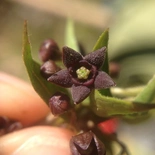Last summer at the edge of my yard, I spotted a vine with an unusual purplish-black, starshaped flower. In the past, I might not have noticed it. But courtesy of the hours we Habitat Gardening in Central New York (NY) Chapter members spent in intimate contact with that plant, I immediately recognized the villain: black swallowwort (Cynanchum nigrum, also known as C. louiseae or Vincetoxicum nigrum). The related pale swallowwort (C. rossicum or V. rossicum) is similarly invasive.

Black Swallow-Wort(Cynanchum louiseae)
Our service project took place in a shady, wooded area of a local park. We gloated over the many garbage bags we filled with the weed, but we had hardly made a dent in the kudzu-like infestation. Even worse, since we were asked only to hand pull the plant, we weren’t killing it, just preventing it from producing seeds that summer. This was helpful, of course, since it can shed up to 2,000 seeds per square yard, and some of the seeds are polyembryonic, and so produce several seedlings. But since it also spreads by rhizomes, ours was only a temporary victory. To eradicate it, we would have had to dig up the crowns or use a herbicide. We had hoped to leave at least a small section of the park swallowwort free, so the outcome was disappointing. Still, the experience was instructive. Seeing the consequences of this plant invasion convinced us that it’s easier to prevent an invasion than to cure one. The despoilment of this formerly beautiful Central New York landscape is a sight we will not soon forget.
We also learned to identify – and notice – this plant, essential for preventing new invasions. Not only did I detect more than one swallowwort growing in my own suburban yard, but we also spotted it on rural land during a Show Me, Help Me tour.
This invasive plant creates some unique problems for wildlife. It harms monarch butterflies in two ways. Since swallowwort is in the milkweed family (Asclepiadaceae), it’s similar enough to native milkweed that monarchs lay their eggs on it. At the same time, it’s different enough that the caterpillars cannot eat it, so they don’t survive. And the impenetrable swallowwort mat crowds out other vegetation, including native milkweed – the essential monarch caterpillar food plant. It also impacts hawks and other predators. The excellent cover afforded mice and similar prey means scanty meals for their predators. And areas infested with swallowwort, aptly nicknamed “dog-strangling vine,” are inhospitable to all wildlife. To people, too.
My swallowwort experiences highlight misconceptions people have about the natural world. A few months after our service project, I happened to be at the park where our chapter had volunteered. In addition to growing in woodland shade, swallowwort also thrives in moist areas, and I spotted it growing near the lake. I pointed it out to my fellow walkers, lamenting that it had spread to this area of the park. To my surprise, one woman assured me that it wasn’t a problem “out here in the wild.” It took me a second to understand what she meant: that we needn’t be concerned since it was “only” in this natural area, and not harming our home landscapes.
This attitude isn’t surprising. As Douglas Tallamy, author of Bringing Nature Home, points out, “When people see green open spaces they think nature has taken over. What they don’t recognize is that the fields of green are overrun with 90 percent non-native growth. A green field in which native plants have been choked out by invasive non-native ones is no more productive than a parking lot when it comes to providing food for insects, birds and other animals.”1
As we work to prevent such invasive plant “parking lots,” we Wild Ones also help people understand the difference between monocultures of plants like swallowwort and natural landscape full of native plants. Important work, indeed.
“UD scientists fears insect food supply affected by non-native plants.” udel.edu

